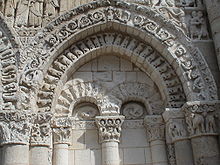Notre-Dame-la-Grande (Poitiers)
Notre-Dame la Grande is an art-historically significant former collegiate church in the French city of Poitiers ( Vienne department ). The current parish church , which stands in the old town next to the Palace of the Counts of Poitou , is also one of the city's main tourist attractions. It is to be assigned to the Poitevine school of Romanesque .
history
A previous building in the same place is mentioned in a document from 924. The present church was largely built in the 11th century and consecrated in 1086 by Cardinal Odon, who later became Pope Urban II . Between 1115 and 1130 the church was extended to the west and received its present magnificent facade.
Extensive reconstructions took place after 1887, and a restoration campaign between 1992 and 1995 .
architecture
West facade
Particularly worth seeing is the west facade of the church, richly decorated with ornaments and depicted with relief depictions of biblical motifs. It comes from the 2nd quarter of the 12th century.
The small-scale decoration of all surfaces with plastic jewelry is generally considered to be the characteristic of western French Romanesque, also called Poitevinian Romanesque after the center of Poitiers .
The main portal in the middle of the ground floor has no tympanum . Instead of side portals, it is flanked by two blind arcades , which a few years before the beginning of the Gothic period ( Saint-Denis abbey church in 1140) end with pointed arches . The area above the portal and blind arcades up to the final ledge on the ground floor is decorated on the left with scenes from the Old Testament , on the right with scenes relating to the birth of Christ. The two galleries on either side of the middle window on the upper floor show thirteen prophets and a pope, the mandorla in the two-storey gable shows Jesus Christ. The stepped arches of the portal and blind arcades are covered with ornaments, possibly letters that are partially alienated by ornaments.
Extensions
Several late Gothic chapels were added to the ambulatory and the north aisle in the 16th century.
inner space
Notre-Dame-la-Grande is a pseudo-basilica : the side aisles have groined vaults at the top of which is the base of the barrel vault of the central nave. The interior is therefore noticeably dark, and because of the unlit upper floor in the middle aisle, pseudo-basilicas are always dark, unless a window in the front side extends below the middle vault in the short nave. The splendid painting was renewed in the 19th century. Parts of the original painting have been preserved in the crypt.
organ
The history of the organs of Notre-Dame-la-Grande goes back to the year 1400. The present organ was completed in 1996 by the organ builder Yves Sévère. It is a polyphonic instrument with 33 registers on three manuals and a pedal . The actions are mechanical.
|
|
|
|
|||||||||||||||||||||||||||||||||||||||||||||||||||||||||||||||||||||||||
literature
- Thorsten Droste : Romanesque Art in France. DuMont Buchverlag , Cologne 1989, ISBN 3-7701-2009-4 , pp. 288–289
- Marcel Durliat : Romanesque Art . Freiburg-Basel-Vienna 1983, p. 480
- Ernst Adam : Pre-Romanesque and Romanesque . Frankfurt 1968, p. 131
- Ingeborg Tetzlaff : Romanesque capitals in France . Cologne [1976] 3rd edition 1979. Fig. 54
- Rolf Toman (ed.): The art of the Romanesque. Architecture - sculpture - painting . Cologne 1996, p. 269
Individual evidence
- ↑ Ville de Poitiers: ' Découvrez l'église Notre-Dame-la-Grande (PDF)
- ↑ More information about the organ
Web links
- "The Collegiate church of Notre-Dame la Grande, Poitiers" (en., Fr.)
- "Notre Dame la Grande de Poitiers" (fr.)
- "Poitiers, Eglise Notre-Dame-la-Grande" (fr.)
Coordinates: 46 ° 34 ′ 59.6 ″ N , 0 ° 20 ′ 38.4 ″ E




